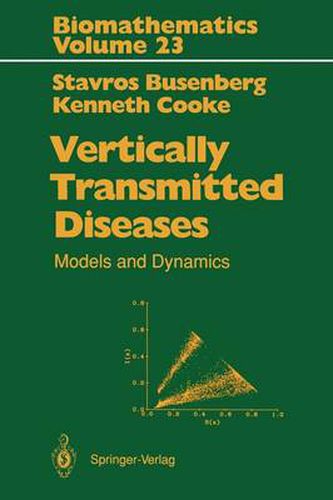Readings Newsletter
Become a Readings Member to make your shopping experience even easier.
Sign in or sign up for free!
You’re not far away from qualifying for FREE standard shipping within Australia
You’ve qualified for FREE standard shipping within Australia
The cart is loading…






This title is printed to order. This book may have been self-published. If so, we cannot guarantee the quality of the content. In the main most books will have gone through the editing process however some may not. We therefore suggest that you be aware of this before ordering this book. If in doubt check either the author or publisher’s details as we are unable to accept any returns unless they are faulty. Please contact us if you have any questions.
Infectious diseases are transmitted through various different mechanisms
including person to person interactions, by insect vectors and via
vertical transmission from a parent to an unborn offspring.
The population dynamics of such disease transmission can be
very complicated and the development of rational strategies
for controlling and preventing the spread of these diseases requires
careful modeling and analysis. The book describes current methods for
formulating models and analyzing the dynamics of the propagation of
diseases which include vertical transmission as one of the
mechanisms for their spread. Generic models that describe broad
classes of diseases as well as models that are tailored to the dynamics of a specific infection are formulated and analyzed. The effects of
incubation periods, maturation delays, and age-structure, interactions
between disease transmission and demographic changes, population
crowding, spatial spread, chaotic dynamic behavior,
seasonal periodicities and discrete time interval events are
studied within the context of specific disease transmission models. No previous background in disease transmission modeling and analysis is assumedand the required biological concepts and mathematical methods are gradually introduced within the context of specific disease transmission models.
Graphs are widely used to illustrate and explain the
modeling assumptions and results. REMARKS: NOTE: the authors have
supplied variants on the promotion text that are more suitable for promotionin different fields (by virtue of different emphasis in the content).
They are not enclosed, but in the mathematics editorial.
$9.00 standard shipping within Australia
FREE standard shipping within Australia for orders over $100.00
Express & International shipping calculated at checkout
Stock availability can be subject to change without notice. We recommend calling the shop or contacting our online team to check availability of low stock items. Please see our Shopping Online page for more details.
This title is printed to order. This book may have been self-published. If so, we cannot guarantee the quality of the content. In the main most books will have gone through the editing process however some may not. We therefore suggest that you be aware of this before ordering this book. If in doubt check either the author or publisher’s details as we are unable to accept any returns unless they are faulty. Please contact us if you have any questions.
Infectious diseases are transmitted through various different mechanisms
including person to person interactions, by insect vectors and via
vertical transmission from a parent to an unborn offspring.
The population dynamics of such disease transmission can be
very complicated and the development of rational strategies
for controlling and preventing the spread of these diseases requires
careful modeling and analysis. The book describes current methods for
formulating models and analyzing the dynamics of the propagation of
diseases which include vertical transmission as one of the
mechanisms for their spread. Generic models that describe broad
classes of diseases as well as models that are tailored to the dynamics of a specific infection are formulated and analyzed. The effects of
incubation periods, maturation delays, and age-structure, interactions
between disease transmission and demographic changes, population
crowding, spatial spread, chaotic dynamic behavior,
seasonal periodicities and discrete time interval events are
studied within the context of specific disease transmission models. No previous background in disease transmission modeling and analysis is assumedand the required biological concepts and mathematical methods are gradually introduced within the context of specific disease transmission models.
Graphs are widely used to illustrate and explain the
modeling assumptions and results. REMARKS: NOTE: the authors have
supplied variants on the promotion text that are more suitable for promotionin different fields (by virtue of different emphasis in the content).
They are not enclosed, but in the mathematics editorial.